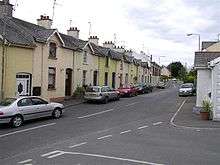Clady, County Tyrone
Clady (from Irish: Claidigh, meaning "muddy margin of a stream or river"[1]) is a small village and townland in County Tyrone, Northern Ireland. It lies about 4 miles from Strabane on the River Finn and borders with the Republic of Ireland. In the 2001 Census it had a population of 423 people. It is within Urney civil parish and the former barony of Strabane Lower. In local government it is part of the Derry City and Strabane District Council. The townland covers an area of 173 acres.[2]

History
The village is one of the oldest in the district. The village is referred to as Claudy[3] in Samuel Lewis' Topographical Dictionary of Ireland, but early and later works attribute the name, Clady,[4][5] distinguishing it from Claudy in County Londonderry.
Next to the village is an important passage over the River Finn, one of the "passes", which controlled the access to Londonderry from the south and east in the times when the ferry at Londonderry was the only means to cross the River Foyle. Originally, the passage at Clady was provided by a ford, known as the Cladyford. Soon a bridge was built, which existed already in the 17th century. According to Lewis in 1840, a "handsome bridge of seven arches" spanned the river near the village.[6]
This passage over the Finn was contested during the Williamite War on 15 April 1689 when Jacobite cavalry under Richard Hamilton and the Duke of Berwick forced the passage.[7] Some days later James II crossed the Finn at this place, proceeded to Londonderry and summoned the city to surrender. With these events started the Siege of Derry.
Clady was also an important ecclesiastical centre, being the location of the first Roman Catholic seminary to be established in the Diocese of Derry.
In February 1922, during the Irish War of Independence, an Ulster Special Constabulary platoon attempting to enter Clady were forced to withdraw two nights in a row after coming under fire from the Irish Republican Army. One USC officer was killed in the clashes.[8]
The Troubles
For more information see The Troubles in Clady (Tyrone), which includes a list of incidents in Clady during the Troubles resulting in two or more fatalities.
Demography
19th century population
The population of the village decreased during the 19th century:[9][10]
| Year | 1841 | 1851 | 1861 | 1871 | 1881 | 1891 |
|---|---|---|---|---|---|---|
| Population | 219 | 155 | 170 | 119 | 121 | 109 |
| Houses | 44 | 35 | 33 | 33 | 28 | 31 |
The population of the townland increased overall during the 19th century:[11][12]
| Year | 1841 | 1851 | 1861 | 1871 | 1881 | 1891 |
|---|---|---|---|---|---|---|
| Population | 50 | 12 | 61 | 49 | 38 | 62 |
| Houses | 10 | 2 | 13 | 9 | 12 | 13 |
In 1891, the town of Clady, which stands in the townlands of Clady and Donnygowen, had an estimated area of 10 acres.[13]
2011 Census
On Census day (27 March 2011) there were 538 people living in Clady.
- 2.2% belong to or were brought up in a 'Protestant and Other Christian (including Christian related)' religion and 97.6% belong to or were brought up in the Catholic religion;
Sport
- Urney St. Columba's is the local Gaelic Athletic Association club.
See also
| Wikimedia Commons has media related to Clady, County Tyrone. |
- List of villages in Northern Ireland
- List of towns in Northern Ireland
- List of townlands of County Tyrone
- Clady, County Londonderry
References
- "Clady". Place Names NI. Retrieved 18 March 2013.
- "Townlands of County Tyrone". IreAtlas Townland Database. Retrieved 18 March 2013.
- Lewis 1840, p. 338, line 31: "CLAUDY, a village in the parish of URNEY, barony of Strabane, county of TYRONE, and province of ULSTER, three miles (S.S.W.) of Strabane;"
- "Statistical Survey of Co. Tyrone 1802". www.cotyroneireland.com. Retrieved 2019-12-29.
- Berwick, James Fitzjames; Hooke, L. J. (Luke Joseph); Montesquieu, Charles de Secondat; Adams, John; John Adams Library (Boston Public Library) MB (BRL) (1778). Mémoires du maréchal de Berwick. John Adams Library at the Boston Public Library. A Paris : Chez Moutard ...
- Lewis 1840, p. 338, line 38: "Close to the village is a handsome bridge of seven arches over the Finn, connecting Claudy with the county of Donegal."
- FitzJames 1778, p. 47: "De là nous marchâmes, le 15 Avril, au pont de Clady, sur la rivière de Strabane, dont les Rebelles, au nombre de dix mille, vouloient défendre le passage"
- Lawlor, Pearse. The Outrages: The IRA and the Ulster Special Constabulary in the Border Campaign. Mercier Press, 2011. pp.202-203
- "Census of Ireland 1851". Enhanced Parliamentary Papers on Ireland. Retrieved 22 March 2013.
- "Census of Ireland 1891". Enhanced Parliamentary Papers on Ireland. Retrieved 22 March 2013.
- "Census of Ireland 1851". Enhanced Parliamentary Papers on Ireland. Retrieved 18 March 2013.
- "Census of Ireland 1891". Enhanced Parliamentary Papers on Ireland. Retrieved 18 March 2013.
- "Census of Ireland 1891". Enhanced Parliamentary Papers on Ireland. Retrieved 18 March 2013.
- FitzJames, James FitzJames, the Duke of Berwick (1778), Mémoires du Maréchal de Berwick (in French), 1, Paris: Moutard
- Lewis, Samuel (1840), A topographical Dictionary of Ireland, 1 (2 ed.), London: S. Lewis & Co.
- NI Neighbourhood Information System
- Ulster Place Names
- Strabane District Council